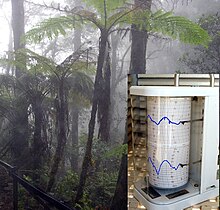
Back Teplota mokrého teploměru Czech Kühlgrenztemperatur German Temperatura#Temperatura húmeda Spanish دمای حباب تر Persian Märkälämpötila Finnish Température du thermomètre mouillé French Teocht fhliuchbholgáin Irish Rigar kwan fitila Hausa Nedves hőmérséklet Hungarian Temperatura di bulbo umido Italian
This article has multiple issues. Please help improve it or discuss these issues on the talk page. (Learn how and when to remove these template messages)
|

| Humidity and hygrometry |
|---|
 |
| Specific concepts |
| General concepts |
| Measures and instruments |
The wet-bulb temperature (WBT) is the temperature read by a thermometer covered in water-soaked (water at ambient temperature) cloth (a wet-bulb thermometer) over which air is passed.[1] At 100% relative humidity, the wet-bulb temperature is equal to the air temperature (dry-bulb temperature); at lower humidity the wet-bulb temperature is lower than dry-bulb temperature because of evaporative cooling.
The wet-bulb temperature is defined as the temperature of a parcel of air cooled to saturation (100% relative humidity) by the evaporation of water into it, with the latent heat supplied by the parcel.[2] A wet-bulb thermometer indicates a temperature close to the true (thermodynamic) wet-bulb temperature. The wet-bulb temperature is the lowest temperature that can be reached under current ambient conditions by the evaporation of water only.
Even heat-adapted people cannot carry out normal outdoor activities past a wet-bulb temperature of 32 °C (90 °F), equivalent to a heat index of 55 °C (131 °F). A reading of 35 °C (95 °F) – equivalent to a heat index of 71 °C (160 °F) – is considered the theoretical human survivability limit for up to six hours of exposure.[3][4]
- ^ Guy W. Gupton (2002). HVAC Controls: Operation & Maintenance. The Fairmont Press, Inc. pp. 288–. ISBN 978-0-88173-394-5.
- ^ A Dictionary of Weather. Oxford Reference. 2008. ISBN 978-0-19-954144-7.
- ^ "Potentially fatal combinations of humidity and heat are emerging across the globe".
- ^ Buis, Alan. "Too Hot to Handle: How Climate Change May Make Some Places Too Hot to Live". Climate Change: Vital Signs of the Planet.